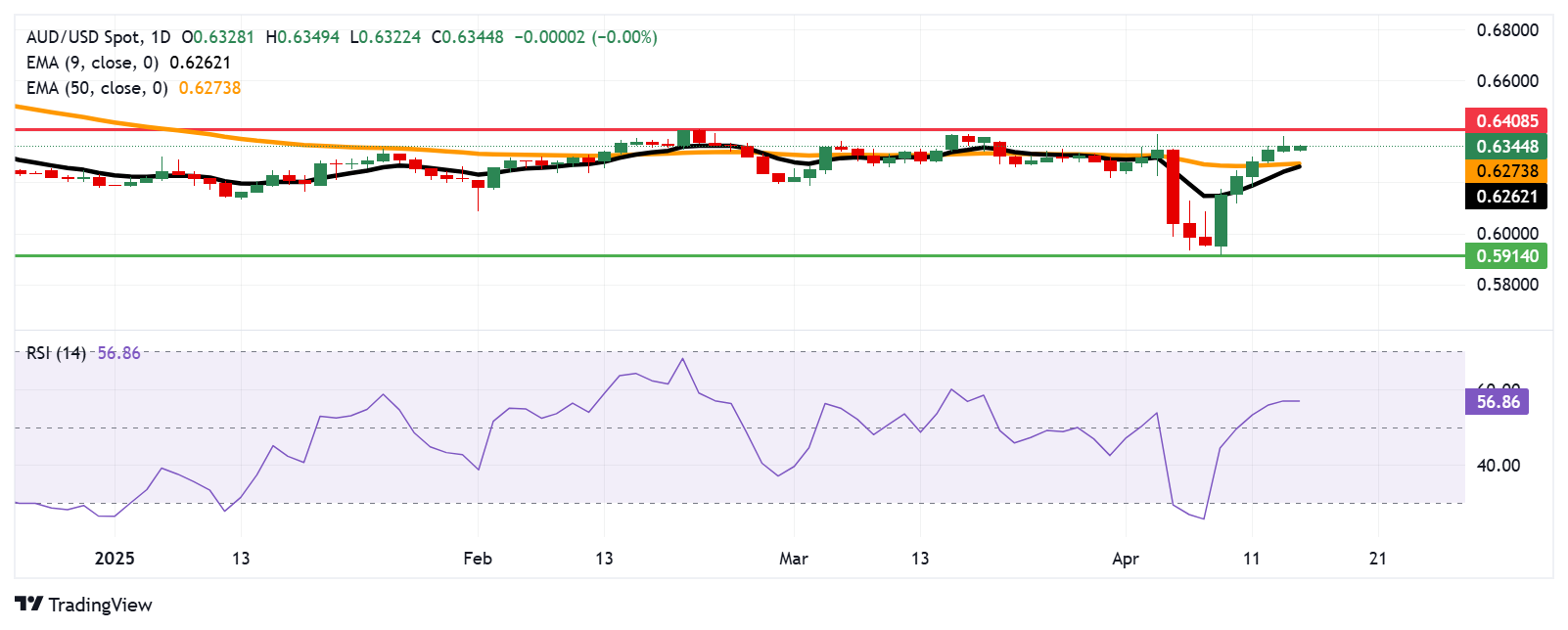-
The Australian Dollar remains resilient despite a softer Westpac Leading Index.
-
China's Q1 GDP growth of 5.4% YoY beats expectations, signaling solid economic momentum.
-
The US Dollar stays subdued as markets await March Retail Sales data.
The Australian Dollar (AUD) continued its upward momentum against the US Dollar (USD) for the sixth straight session on Wednesday, with the AUD/USD pair remaining firm around the 0.6350 level. This strength followed the release of Australia’s Westpac Leading Index, which saw its six-month annualized growth rate ease to 0.6% in March from 0.9% in February—signaling a slight slowdown in economic momentum over the next three to nine months.
Supporting the Aussie was upbeat economic data from China, Australia’s largest trading partner. China's economy grew 5.4% year-over-year in Q1 2025, outpacing expectations of 5.1% and matching the growth rate seen in Q4 2024. On a quarterly basis, GDP rose 1.2%, slightly below the forecasted 1.4% gain and Q4's 1.6% expansion.
Additionally, China’s Retail Sales surged by 5.9% year-over-year, topping expectations of 4.2% and improving from February’s 4.0%. Industrial Production also beat estimates, jumping 7.7% compared to forecasts of 5.6% and February’s 5.9%.
Global risk appetite improved after US President Donald Trump announced exemptions for key tech products—including smartphones, semiconductors, solar panels, and flat-panel displays—from new “reciprocal” tariffs. The move eases concerns over further disruptions in trade with China, supporting Australian exports.
Australia’s 10-year government bond yield fell to 4.33% after the Reserve Bank of Australia (RBA) released minutes from its March 31–April 1 policy meeting. The minutes showed that Q1 data reflected trimmed mean inflation below 3% and signs of strengthening consumer demand. While the RBA flagged the May meeting as a potential time to adjust policy, no firm decision was made. Markets are currently pricing in a 25-basis point rate cut in May and expect about 120 basis points of easing through 2025. Investors now turn their attention to Thursday’s employment report for further clues.
US Dollar Remains Under Pressure Amid Weak Sentiment and Mixed Data
- The US Dollar Index (DXY) hovered near 99.80, weighed down by cautious investor sentiment. Upcoming US Retail Sales data for March will be closely watched for insights into how tariffs and inflation are affecting consumption.
- A consumer sentiment survey by the New York Fed highlighted growing pessimism, with households anticipating higher inflation, weaker job prospects, and tighter credit conditions. Meanwhile, Atlanta Fed President Raphael Bostic reiterated that the Fed still faces a long journey to achieve its 2% inflation target, dampening hopes for imminent rate cuts.
- The University of Michigan's sentiment index dropped to 50.8 in April, with one-year inflation expectations spiking to 6.7%. The US Producer Price Index (PPI) rose 2.7% year-over-year in March, down from 3.2% in February, while the core PPI eased to 3.3%. Initial jobless claims rose slightly to 223,000, while continuing claims fell to 1.85 million—painting a mixed labor market picture.
- Trade tensions resurfaced as China’s Ministry of Finance retaliated against US tariff hikes by increasing duties on American goods from 84% to 125%. This followed President Trump’s decision to raise tariffs on Chinese imports to 145%, intensifying fears of a global slowdown.
- The US Consumer Price Index (CPI) cooled to 2.4% year-over-year in March, down from February’s 2.8% and below the 2.6% forecast. Core CPI also eased to 2.8%, missing the expected 3.0%. On a monthly basis, headline CPI declined by 0.1%, and core CPI rose just 0.1%.
- In China, the People's Bank of China (PBoC) is expected to implement additional stimulus in Q2 2025. Citi analysts project a 15-basis point cut to the Loan Prime Rate (LPR) and at least a 25-basis point reduction in the Reserve Requirement Ratio (RRR) to support domestic growth amid external headwinds.
Technical Outlook: AUD/USD Maintains Bullish Momentum
Technically, the AUD/USD pair continues to exhibit a bullish bias, trading above both the 9-day and 50-day Exponential Moving Averages (EMAs). The 14-day Relative Strength Index (RSI) also holds above the neutral 50 level, reinforcing positive momentum.
A breakout above the psychological resistance at 0.6400 could trigger a retest of the four-month high at 0.6408, last reached on February 21. On the downside, initial support lies near the 50-day EMA at 0.6273, followed by the 9-day EMA at 0.6262. A decisive drop below these levels could shift the short-term outlook to bearish and potentially lead the pair toward the March 2020 low of 0.5914 and the key 0.5900 level.
AUD/USD: Daily Chart






